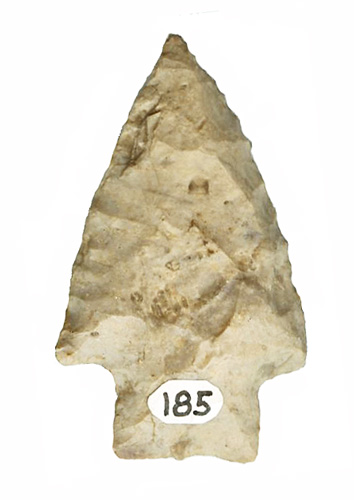

Point Type: KAYS
a.k.a Kays
Stemmed
Also See: Atlantic, Appalachian, Bare
Island ,
Heavy
Duty , Newmanstown, Oak Grove, Piedmont,
Saratoga Parallel Stemmed, Savannah River, Stone Square Stemmed
Location: Southeastern United States, especially
Tennessee, Alabama, Mississippi and parts of adjacent states
Associated Dates:
5000 - 3000 B.P. - Middle to Late Archaic
Morphology: Stemmed
General Description: The Kays is a large
dart point and knife which has
straight to convex edges on the blade. The stem
is short, straight sided, and rectangular with
straight or slightly convex basal edge .
The shoulders are angular and some specimens
may exhibit slightly barbed shoulders and may be
rounded.
Flaking is conchoidal to
midsection and then the blade edges get secondary retouch. The blade
and stem are shaped by broad, shallow to deep flaking. Random flaking is
usually employed however a few examples do show collateral flaking. The cross section is usually flat, biconvex or plano-convex and moderately
thin. The hafting area my be
lightly ground
.
The size of the Kays can range from 42 mm to 105 mm in length
with the average being 63 mm. Shoulder width - maximum, 32 mm, minimum
26 mm, average 30 mm. Stem length ranges from 16 mm to 10 mm, average
14 mm. Stem width ranges from 19 mm to 14 mm average
17 mm . Thickness ranges from 11 mm to 7 mm.
The Kays points are
similar in form and age to the Genesee points found in New York, Savannah River,
Oak Grove and Appalachian points as well as many other local stemmed
point types of the Archaic period in the Eastern United
States.
The Kays Stemmed point type was named by Madeline
Kneberg in 1956 after the Kays Landing Site in Henry County, Tennessee where
numerous specimens were recovered.
About the Point Above: The very small Kays point pictured at the top of this page, is from western Kentucky. This specimen measures 46 mm in length, 28 mm wide
at the barbs and 7 mm at its thickest point (at the junction of
the stem and blade). The stem is 18 mm wide and 10 mm long.
The stem shows mild grinding on the all three
sides. The blade has be reworked and there is bifacial retouch along
all blade edges. This blade is made from a matte light cream colored Fort Payne
chert with light gray and tan inclusions. The surface is worn and is
patinated. Catalog Number
185-19-C
References: Baker, Cambron & Hulse, Hranicky (1), Justice (1), Overstreet, Perino (2)
© Copyright 1997 - 2009 LITHICS-Net WWW.LITHICSNET.COM
Use Your Browser's BACK Button to Return to the LITHICS-Net Index.